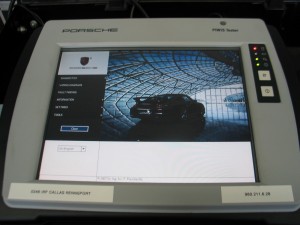
The history of Porsche diagnostic testers basically all started with the Bosch D-Jetronic fuel injection system tester for the 914 in the early 70’s. Then we received the 9268 digital output fault code reader in 1987 which would present the technician with an actual fault code number. The retrieved fault code corresponded to different conditions or problems recorded by the cars on board computer. The 9268 was intended to interface with the newly designed 16 valve 944S and 928 S4. This was eventually replaced by the 9288 nicknamed the Bosch Hammer because it was in the shape of a hammer, codenamed the PST-1 (Porsche Systems Tester-1) computerized diagnostic tester, circa 1989. The 9288 was mainly designed to interface with the 1989-on 964’s (911) and had to be capable of performing a “system adaptation” which was to reset all the controllers, much like a computer reboot. Later this procedure became known as a “vehicle handover”.
Following the 9288 Hammer, Porsche completely changed their approach of the system tester hardware to the Microsoft based tablet called the PST-2 for the 993’s (911’s) in 1994. The PST-2 was much more advanced than all previous testers because it had to be capable of diagnosing the soon to come OBD-II (On Board Diagnostics-II) engine management system. OBD-II was federally mandated in the U.S. as the standard by which all cars operated with starting in 1996.
In 2004 Porsche released a newer and revised touch screen version of the Microsoft based tablet. This version was called the Porsche Integrated Workshop Information System (whew) or better known as the PIWIS-I (Codenamed the PST-3). The PIWIS-I was very similar to the older PST-2 but could handle the extreme electronic data interfacing necessary in the 987, 997 and the Cayenne (9PA) truck.
Now in an unprecedented move, Porsche has just recently announced in a press release to Independent Repair Facilities (IRF’s) stating that as of December 31, 2011 at midnight, the PIWIS-I testers that were previously purchased will cease to operate. This leaves everyone who purchased a PIWIS-I no choice but to purchase the new systems tester named the PIWIS-II (Codenamed PST-4). The new PIWIS-II is also Microsoft based but this time it is literally installed on a Panasonic CF-30 “Tough Book” touch screen laptop computer. Included in the package is a VCI (Vehicle Communications Interface) module, all the necessary data cables, connectors and a standard (hefty) annual maintenance fee. This new tester is the only communications device allowed to shake hands with the new 2010 Panamera (970) and Cayenne’s (92A). Most likely this will also be the situation with the new 991 (911) model set to be released soon.
As the cars have become more electronically sophisticated, the need to interface with them and download the enormous volumes of data has required the diagnostic equipment to be just as complex. Many of the vehicle’s electronic systems require handshakes from other, seemingly unrelated, systems throughout the car to properly operate. These convoluted interfaces can yield unexpected failure scenarios; e.g., a fuel delivery issue being caused by a component failure in the airbag system. Therefore, only with these tools, equipment and information can the technician then properly diagnose the issues with the automobile.
Today, models like the 970 Panamera do not have an engine oil dipstick; the instrument cluster displays the engine oil level information. Despite that fact, you cannot even check the engine oil level immediately after an oil change without utilizing the correct diagnostic tester. Once the front hood has been opened, the instrument cluster will not display the engine oil level until the car has been driven for 6 miles.
At the end of the day the cost to repair your Porsche will go up. Regardless of who does the work, the price of the tools and the software has become very significant. Porsche, like all automobile manufactures, has reached a level of electronic sophistication that will make your head spin. Even the simplest of repairs can no longer be made without the correct diagnostic equipment.
Tony Callas & Tom Prine